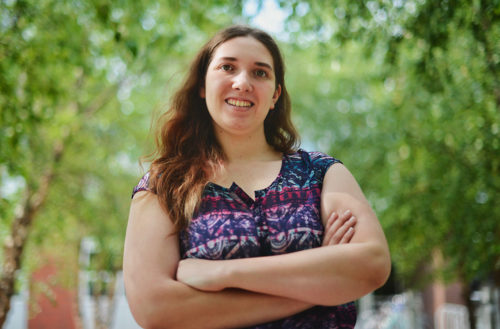Central College senior Michaela Van Dusseldorp tells a captivating story in her psychology research: After being sentenced to prison previously for grand theft, Jeremy Meeks was arrested again — this time for street terrorism, obstruction of justice and an illegal weapons charge. However, when police shared his mugshot on Facebook, Meeks was quickly recognized not for his crimes, but for his stunning looks. He received a two-year sentence and after one year, was hired as a model for a major fashion company. Immediately after being released, Meeks strutted down the catwalk at New York Fashion Week.
The story raises many questions about the effects of attractiveness in our society, says Van Dusseldorp. Would Meeks have received such a short sentence if he were unattractive? Would he have been treated similarly if he were black? There’s a significant gap in legal psychology, Van Dusseldorp says, and she’s working to find answers these questions. Last spring, Van Dusseldorp was accepted to present her work at the Midwestern Psychological Association conference in Chicago. Her research analyzed responses from more than 250 participants. This summer, she is one of 17 Central College students chosen to receive a research grant, enabling her to expand this research further with assistant professor of psychology Ashley Scolaro.
This research might surprise you — what would you expect to observe when juries sentence offenders?
True or false? White, attractive defendants are most likely to receive lenient sentences.
False. This is the main question in Van Dusseldorp’s research with Scolaro, and she found no significant difference in sentence length. The sentences are in fact nearly identical for any combination between black or white and attractive or unattractive defendants. Wondering how researchers measure attractiveness? Scolaro and Van Dusseldorp chose photos from the Chicago Face Database, using the collection’s most and least attractive images, based on data from previous studies.
True or false? Defendants are likely to be sentenced more harshly for a crime that fits racial stereotypes.
True. Researchers have shown that individuals of different races are often associated with certain crimes. For example, Van Dusseldorp explains, individuals easily associate black offenders with violent crimes like gang activity, while white offenders are easily associated with white-collar crimes like embezzlement. This is where studies do reveal a tendency for harsher sentences — whenever the crime fits a racial stereotype. Jurors are more confident in their decisions, says Van Dusseldorp, when their pre-existing beliefs are confirmed. In fact, jurors even remember evidence better if it agrees with cultural stereotypes — and rely on that evidence when deciding sentences. In Van Dusseldorp’s study, defendants are charged with vehicular manslaughter, a non-stereotypic crime.
True or false? Attractiveness will always work in defendants’ favor.
False. Although attractive defendants often receive more lenient sentences, Van Dusseldorp explains, this only occurs when their crimes have nothing to do with their beauty. This theory has been tested with crimes like swindling, when offenders use manipulation and deception to steal a person’s money. In such cases, jurors are more likely to judge offenders harshly for abusing their power of attractiveness.
True or false? Jurors are most likely unaware of any bias or racial prejudice.
False. Van Dusseldorp concludes that, contrary to popular belief, many Americans are hyper-aware of racial prejudice and biases. Other studies have shown jurors may exhibit signs of implicit racial bias until they deliberate as a group. At that point, Van Dusseldorp explains, jurors are forced toward explicit bias, and they make an effort to control and reduce any prejudices to adhere to social norms.
Read about more summer research to discover Central students’ work in prairie biology, spintronics, neuroscience and more.
